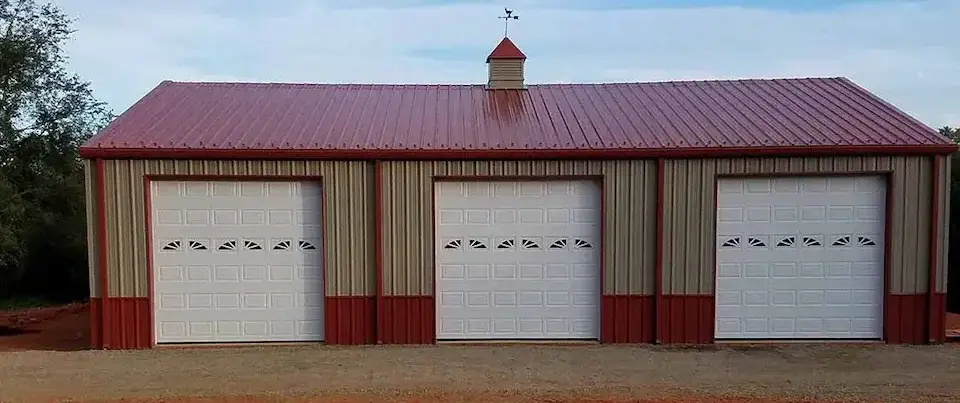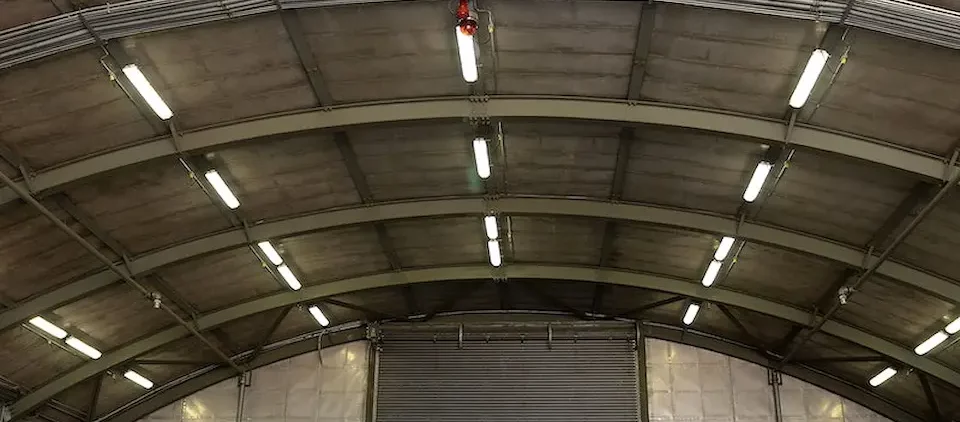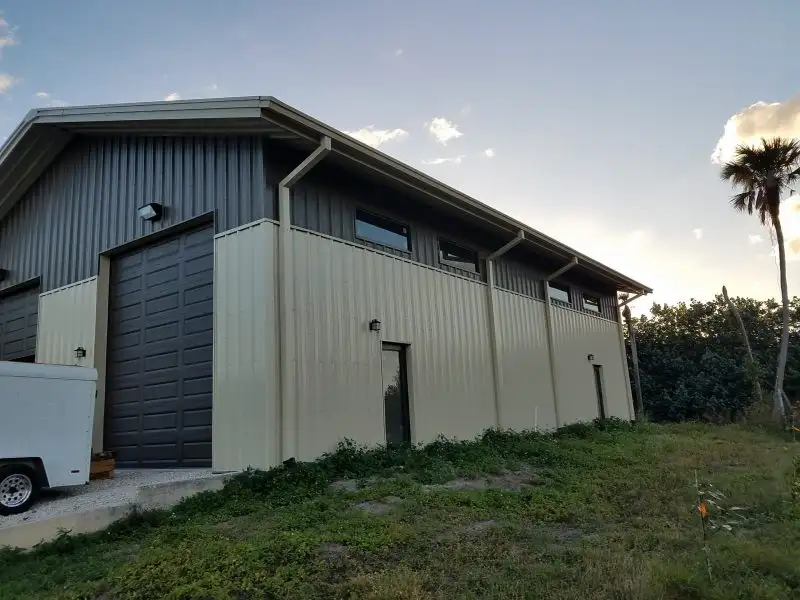Whether you’re a seasoned RV enthusiast or a newbie exploring the freedom of life on the road, finding the perfect shelter for your prized recreational vehicle is crucial. That’s why our experts in metal RV shelters are delving into the world of metal buildings, showcasing their versatility, durability, and space-maximizing potential.
From creative storage solutions to weatherproof designs, join us as we explore how these RV shelter ideas can revolutionize protection while maximizing every inch of available space.
Table of Contents
Advantages of Metal Buildings for RV Shelters
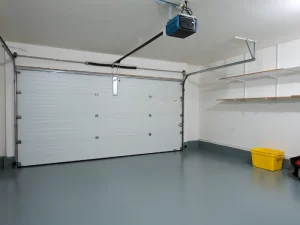 When it comes to protecting your recreational vehicle, prefabricated metal garages offer a number of advantages that make steel structures the ideal solution for RV protection through all seasons.
When it comes to protecting your recreational vehicle, prefabricated metal garages offer a number of advantages that make steel structures the ideal solution for RV protection through all seasons.
Durability and Strength
Metal buildings are renowned for their exceptional durability and strength. Constructed with high-quality materials such as steel or aluminum, steel garages for RVs are built to withstand the test of time and various weather conditions. From heavy snow loads to strong winds, metal buildings provide a robust shelter that ensures the safety and longevity of your RV.
Low Maintenance
Unlike other building materials like wood that may require frequent repairs and upkeep, metal buildings are designed for minimal maintenance. The inherent strength and durability of a custom metal RV building eliminates the need for constant painting, sealing, or wood treatment. This not only saves you time and effort but also reduces long-term maintenance costs, allowing you to focus on enjoying your RV adventures rather than how to maintain your storage space.
Customizability
Whether you require additional storage space for equipment, an attached workshop, or specific dimensions to accommodate multiple vehicles, metal RV buildings can be easily tailored to meet your needs. With flexible designs and a variety of customizable features such as doors, windows, and interior layouts, you can create a custom metal building that perfectly fits your lifestyle.
Energy Efficiency
With the increasing focus on energy conservation, metal buildings provide excellent energy efficiency for RV shelters. Their insulated panels and advanced roofing systems help regulate temperature and minimize heat transfer, resulting in reduced energy consumption for heating and cooling.
Sustainability
Made from recyclable materials, such as steel, a metal RV building has a significantly lower carbon footprint compared to traditional construction materials. By opting for a metal RV shelter, you can align your passion for outdoor exploration with eco-friendly principles.
RV Shelter Ideas for Maximizing Space

Overhead Storage and Mezzanines
The quickest way to gain room is to build up, not out. Mezzanines over the tongue area or rear bay of your metal building creates safe zones for totes, seasonal gear, or spare tires while keeping the floor open for maneuvering.
Over-ceiling racks and simple pulley systems let you hoist bulky items—kayaks, generators, ladders—without blocking doors or windows. Gambrel or vertical roof styles increase headroom, giving your rv shelter idea the vertical clearance needed for lofts without compromising door heights.
Wall Storage and Modular Systems
Walls are your largest untapped asset when it comes to considering RV shelter ideas for maximized space. Continuous runs of cabinets, pegboard, and slatwall keep tools, hoses, and chemicals organized and off the floor.
Choose modular components you can rearrange as your storage needs evolve, and include shallow-depth units where space is tight near doors. Fold-down benches and sliding racks create work zones that vanish when it’s time to park or pull out.
Dual-Purpose Zones
Design your metal RV building to do more than just store your RV. A partitioned workshop, gear room, or small utility nook turns downtime into productive time—winterizing, light repairs, or trip prep. Operable curtains or demountable walls let you convert one bay from a staging area to open parking in minutes. If you travel for long stretches, a compact lounge or prep area can make pre-trip load-outs faster and more comfortable.
Traffic Flow Planning
Good circulation prevents dings, delays, and frustration. Map your RV’s path from door to final position, then maintain clear aisles on both sides and behind the rig for maintenance access.
Leave buffer zones for slide-outs, rear ladders, and service doors so you don’t have to move storage each time you set up. Mark the floor with painted guides or low-profile wheel stops to park accurately without guesswork.
Lighting and Visual Illusion
Bright, even light makes a smaller footprint feel bigger—and safer to work in. Clerestory windows or translucent roof panels bring in daylight without sacrificing wall storage. Layer LED lighting—overhead fixtures for general illumination, task lights over benches, and under-loft strips—to eliminate shadows and create the perception of additional height. Light-colored interiors and reflective finishes on ceilings is a great metal RV shelter idea to amplify brightness and help your space feel open even in fully enclosed RV garages.
Metal RV Shelter Ideas for Security and Protection
Your rv shelter idea should do more than store the vehicle—it should actively protect it from theft, weather, and wear. Focus on layered self-storage security (deter, detect, delay) and resilient construction (resist wind, hail, and moisture).
The following strategies help safeguard your RV, tools, and accessories while keeping day-to-day access convenient.
High-Security Doors and Access Control
Oversized roll-up or sectional doors should include reinforced tracks, tamper-resistant fasteners, and interior slide locks. Pair these features with smart keypads or proximity readers so you can grant temporary access without sharing keys. For man doors, choose heavy-gauge steel with deadbolts and continuous hinges, and position sightlines so passersby can’t see valuables from outside.
Perimeter Planning and Site Visibility
When it comes to your RV shelter ideas, good site design deters opportunistic theft before anyone reaches the building. Keep landscaping low near doors and windows, maintain clear sightlines from the street or house, and avoid creating hidden niches. Perimeter fencing, motion-activated floodlights, and visible cameras signal that your steel RV shelter is monitored and not an easy target.
Lighting, Cameras, and Alarm Integration
Layer lighting to remove dark corners. Think bright general LEDs, motion floods at entries, and task lighting inside the structure. Add cameras at door heads and corners to capture both approach and license plates. Tie sensors into a monitored alarm or your smart home platform for instant alerts and event recording in the event someone attempts to breach your metal RV building for theft.
Wind, Snow, and Impact Resistance
Specify wind and snow loads appropriate to your locality and consider bracing, heavier gauge panels, and additional anchoring for exposed sites. Vertical roof systems are a beneficial RV shelter idea to implement, as this type of roofing sheds water and snow more effectively, reducing load and leak risk. In hail-prone areas, opt for impact-rated panels or roof profiles designed to resist denting and puncture.
Moisture, Condensation, and Rust Control
Moisture is a slow threat to both steel building structures and stored RVs. Use vapor barriers, ridge vents, and powered exhaust to limit humidity and prevent condensation drips. Insulated metal panels or properly installed blanket insulation reduce temperature swings, while floor drains and positive slab slope move water away from tires and jacks.
Fire Safety and Electrical Protection
Every strong RV shelter idea for protection should consider safety measures. Install dedicated circuits for shore power with GFCI/AFCI protection and a visible disconnect and avoid overloaded extension cords. Keep a rated fire extinguisher near each exit and store fuels or solvents in vented, approved cabinets. Additionally, incorporate whole-building surge protection to guard sensitive RV electronics during storms or utility events.
Secure Storage for Tools and Accessories
Lockable cabinets and anchored tool chests reduce theft risk and keep the floor clear for safe movement. Wall-mounted racks for hoses, cables, and ladders prevent tripping hazards and keep gear away from hot exhaust components. If you store generators or batteries in your metal RV building, use ventilated enclosures and follow manufacturer clearances.
Door and Window Placement for Defense
When designing a custom metal building to bring your RV shelter idea to life, be sure to place windows high or use narrow, clerestory styles to admit light without exposing contents. Avoid aligning windows directly with major storage zones or where you normally park your RV.
Top Considerations Before Bringing Your RV Shelter Idea to Life
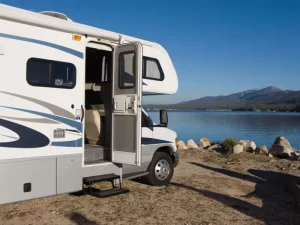
Site, Access and Orientation
Getting the site right determines how easily you can move your RV in and out—and how well the shelter resists weather long-term. Think about approach angles from the street, overhead obstructions, and water flow across your property. A smart orientation can also reduce heat gain, wind exposure, and splashback during storms.
Local Building Codes and Permitting
Every jurisdiction treats height, setbacks, and loads a bit differently, especially for tall doors and long spans. Reviewing requirements up front helps you choose the right framing, roof pitch, and anchoring—and prevents delays once materials arrive. Engineering stamps and inspections are common for enclosed structures or high wind and snow regions.
Foundation and Footing Options
Your metal building foundation choice affects cost, build speed, moisture control, and how you’ll use the space day to day. Enclosed garages and workshop spaces typically benefit from a slab, while open carports can succeed with simpler footings. No matter the approach to your RV shelter idea, plan for drainage and soil stability to keep the structure dry and true over time.
Budget and Phasing Strategy
A clear budget—and a phase plan—lets you start protecting your RV sooner and upgrade as needs evolve. Many owners begin with a shell and add insulation, doors, or interior finishes later. Separating “must-haves” from “nice-to-haves” keeps the project on track without sacrificing long-term flexibility.
FAQs for RV Shelter Ideas
Do I really need insulation in my RV shelter?
Insulation is optional if your RV is well-sealed and you’re not occupying the shelter year-round. However, it helps prevent condensation, keeps interior temperatures more stable, and protects wiring and stored materials.
What typical dimensions are recommended for an RV garage?
Common garages are sized at 16×50, 24×48, 35×60, or 40×40. Aim for at least 12-18” extra on each side, plus height overhead.
Can I convert an existing carport into a full garage later?
Yes. You can retrofit walls, doors, and insulation later to convert a metal carport into enclosed metal building space as your needs evolve.
Does an RV shelter need a concrete slab foundation?
Not always. Some shelters work with pier or pad foundations. But a slab is preferred for flat, clean surfaces suitable for workshops and easier movement.
How long does it take to build a metal RV shelter?
A prefabricated metal building shell can often be erected in a few days. Full finish-outs that incorporate insulation, HVAC, and interior upgrades may take additional weeks depending on complexity.
Contact Champion Buildings for Top Quality Metal RV Buildings
When it comes to choosing the ideal shelter for your RV, our metal building experts from Champion Buildings are here to discuss your RV shelter ideas, provide professional guidance, and assist you in starting the journey toward creating a secure and efficient shelter for your recreational vehicle.
Give your RV the protection it deserves with a reliable and durable metal building—contact us today by calling (800) 942-6812 or filling out the contact form below to get started.

